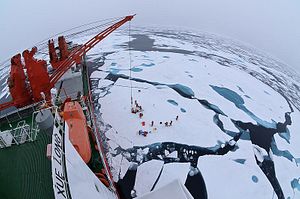Members of the Polar Navigation and Equipment Committee, a technical organization set up under the China Institution of Navigation (CIN), convened for a joint general assembly and a forum on polar navigation and infrastructure on September 26 — just after the polar research vessel Xue Long 1 had anchored at its homeport of Shanghai, marking the completion of China’s ninth Arctic expedition. The assembly resulted in the election of Liu Shanlin, the party secretary of the Polar Research Institute of China (PRIC) as the committee’s first chairman. Cai Meijiang, vice manager of the China Ocean Shipping Company (COSCO) subsidiary COSCO Shipping Specialized Carriers, was elected to be the deputy chairman. The current captain of the Xue Long 1 research icebreaker, Shen Quan, received the post of secretary-general. Other institutions represented on the committee include the Jiangnan Shipyard Group, several university-based engineering departments, and the Center for Marine Environmental Forecasting. The committee itself was established only two months ago in July, during a CIN council meeting. A committee on nautical charts and another one on shipping insurance were also set up.
Liu, the newly elected chairman, stated that the committee’s mission is, inter alia, to further China’s polar science, develop new technologies for the polar regions, and to build a shared platform to better utilize accumulated data and knowledge in polar navigation. Another statement added that the committee will help to better “understand, protect, and exploit the polar regions.”
China’s polar administration and research institutes have just finished this year’s Arctic expedition. Prior to the voyage, which covered some 12,500 nautical miles in 69 days, testing the navigability of Arctic sea lanes was stated as one of the expedition’s primary objectives, along with the study of sea fog and other meteorological conditions that pose challenges to safe navigation. This year’s expedition was also hailed as the first expedition northward that would focus on the deployment and servicing of a myriad long- and short-term unmanned research stations — what Chinese polar scientists have discussed as the “professionalization” or “standardization” of the country’s observational network in the Arctic region. To this effect, the Chinese media celebrated that China’s Arctic observation network now had “entered the unmanned era.”
In late September, a Sino-Russian Arctic research expedition set sail from the Russian port of Vladivostok. Organized by the Russian Pacific Ocean Research Institute, the voyage took on board 11 Chinese scientists belonging to various maritime research institutions. The Russian organizers expressed that the scientific cooperation between the two countries will be a boost to climate research in the Arctic, as well as helping to realize the vision of a Polar Silk Road.
Adding to this, China’s polar shipbuilding is on an upclimb. The research vessel Xue Long 2, the first polar icebreaker to be built by a Chinese shipyard, was launched last month and will enter service sometime next year. The ship’s design has been a collaborative effort between Finnish icebreaker experts Aker Arctic and Chinese shipbuilders, very much treated as a learning opportunity. Earlier in September, the COSCO Shipping Specialized Carrier vessel Tian En, an ice-class cargo ship, completed the Arctic leg of its journey from China’s east coast to various European ports after having transited the Northeast Passage. Also last month, the keel was laid down for the construction of a Russian multipurpose icebreaker tug at a shipyard in the city of Zhenjiang. Earlier in July, The Diplomat reported that a tender had been published for the construction of the country’s first nuclear-powered icebreaker. Chinese shipyards are set to provide up to 80 percent of the hardware required for the Yamal LNG project on the Russian Yamal Peninsula, where Chinese Sinopec holds a 20 percent stake — so far the largest materialization of Beijing’s plans for a glacial silk road. This stands in stark contrast to other Arctic states, such as the United States, which is currently feeling the pressure of its deteriorating polar fleet and loss of shipbuilding expertise
Plans for a Polar Silk Road were crystallized in the Arctic White Paper published in January this year. The document held the first official incorporation of the Arctic region into China’s Belt and Road Initiative (BRI) framework as a potential “silk road on ice.” The white paper was followed by the announcement of a massive restructuring of the state bureaucracy. This was significant for China’s polar program, as the Ministry of Land Resources, which has traditionally overseen the country’s polar activities, was effectively streamlined and renamed the Ministry of Natural Resources (MNR). It is tasked with surveying and managing the country’s natural resources and has consolidated much of the bureaucracy pertaining to national land and maritime resources. A large part of the responsibilities originally held by the State Oceanic Administration (SOA), under which China’s polar activities previously were organized, have been absorbed by the new ministry.
This year’s Arctic expedition was the first polar expedition organized under the aegis of the MNR, and the change means that future polar expeditions are organized directly under the new ministry, and not by a subministerial agency. A review of polar-related announcements will reveal that the position of SOA as the main organizers has been replaced by the new ministry. Yet, according to a notice issued by the ministry in May, the SOA still retains decisional authority when it comes to approving polar research projects.
The creation of the Polar Navigation Committee stands as a new step, among several recent ones, in the ongoing process of institutionalizing Beijing’s planned Polar Silk Road — the development and integration of the country’s polar assets to achieve greater connectivity in tune with the wider BRI framework. To this end, it signals a more organized engagement across institutions and industries that pertain to China’s polar interests by facilitating knowledge sharing and providing new linkages bolster scientific as well as commercial platforms in the polar regions.
Trym Aleksander Eiterjord is a graduate student at the University of Oslo, Norway.

































